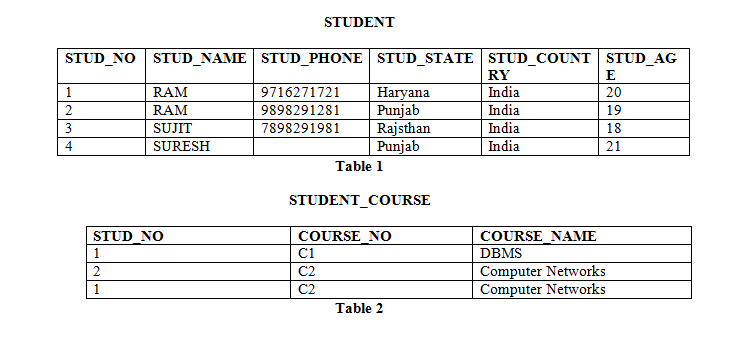Types of Keys in Relational Model (Candidate, Super, Primary, Alternate and Foreign) - GeeksforGeeks
Types of Keys in Relational Model (Candidate, Super, Primary, Alternate and Foreign)
Different Types of Keys in Relational Model

Candidate Key: The minimal set of attributes that can uniquely identify a tuple is known as a candidate key. For Example, STUD_NO in STUDENT relation.
- The value of the Candidate Key is unique and non-null for every tuple.
- There can be more than one candidate key in a relation. For Example, STUD_NO is the candidate key for relation STUDENT.
- The candidate key can be simple (having only one attribute) or composite as well. For Example, {STUD_NO, COURSE_NO} is a composite candidate key for relation STUDENT_COURSE.
- No of candidate keys in a Relation are nC(floor(n/2)),for example if a Relation have 5 attributes i.e. R(A,B,C,D,E) then total no of candidate keys are 5C(floor(5/2))=10.
Note – In SQL Server a unique constraint that has a nullable column, allows the value ‘null‘ in that column only once. That’s why the STUD_PHONE attribute is a candidate here, but can not be ‘null’ values in the primary key attribute.
Super Key: The set of attributes that can uniquely identify a tuple is known as Super Key. For Example, STUD_NO, (STUD_NO, STUD_NAME), etc.
- Adding zero or more attributes to the candidate key generates the super key.
- A candidate key is a super key but vice versa is not true.
Primary Key: There can be more than one candidate key in relation out of which one can be chosen as the primary key. For Example, STUD_NO, as well as STUD_PHONE both, are candidate keys for relation STUDENT but STUD_NO can be chosen as the primary key (only one out of many candidate keys).
Alternate Key: The candidate key other than the primary key is called an alternate key. For Example, STUD_NO, as well as STUD_PHONE both, are candidate keys for relation STUDENT but STUD_PHONE will be an alternate key (only one out of many candidate keys).
Foreign Key: If an attribute can only take the values which are present as values of some other attribute, it will be a foreign key to the attribute to which it refers. The relation which is being referenced is called referenced relation and the corresponding attribute is called referenced attribute and the relation which refers to the referenced relation is called referencing relation and the corresponding attribute is called referencing attribute. The referenced attribute of the referenced relation should be the primary key for it. For Example, STUD_NO in STUDENT_COURSE is a foreign key to STUD_NO in STUDENT relation.
It may be worth noting that unlike, Primary Key of any given relation, Foreign Key can be NULL as well as may contain duplicate tuples i.e. it need not follow uniqueness constraint.
For Example, STUD_NO in STUDENT_COURSE relation is not unique. It has been repeated for the first and third tuples. However, the STUD_NO in STUDENT relation is a primary key and it needs to be always unique and it cannot be null.










